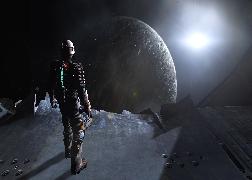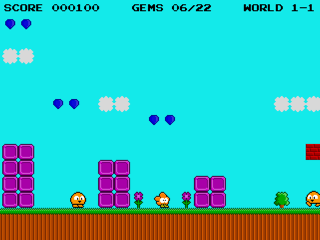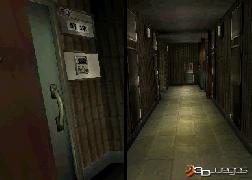
Atmosphere? Check. Difficulty? Not so much.
My goal in running this site, as
I originally wrote back in 2003, is to identify the characteristics common to all good horror games. Five years later I’m going to revise that statement a little, because for every rule that I can come up with there is at least one major exception. So I am going to omit the “all” portion of my goal statement and focus on the major characteristics that good horror games
tend to employ. In this first post on this topic, I want to talk about the role of atmosphere and difficulty. Now, atmosphere is probably a characteristic worthy of its own post, but for now I’d like to discuss the atmosphere as it directly relates to difficulty in horror games.
Above-average difficulty is a common trait in popular horror games. The original Resident Evil is a hard game; on top of difficult controls the designers go out of their way to force the player to aggressively ration their resources. Other than Capcom’s Maximo, I can’t think of any games outside of the horror genre that effectively punish the player for saving their progress. Resident Evil 4, a much newer game, has been streamlined and simplified, but it’s still a pretty challenging game. And generally, I think horror games are a lot less forgiving about the degree of challenge that they apply to the player; there’s often no option to continue, save points are few and far between, and most protagonists can only withstand a few enemy attacks before they are killed.
At first I thought that difficulty was there just to increase the amount of stress that the player experiences while playing the game. Making death an all-to-easy outcome of any given encounter heightens the player’s need to move carefully and make few mistakes, which I figured helped the game feel scary. While that assessment is true, it doesn’t go deep enough. I now think that difficulty is directly tied to the feelings of fear that good horror games are able to create, and not just because the threat of death is stressful.
A couple of years ago game designer and author of a fascinating blog Dan Cook authored an article about generating artificial emotions (link probably requires Gamasutra.com registration). In it he discusses a cognitive science theory called the Two Factor Theory of Emotion. Dan says,
The theory states that in order for an emotion to be felt, two factors must be present:
- Physiological change: The person feels elevated heart rate, sweaty skin and other elements of physiological arousal.
- Cognitive label of the physiological change: Based off the context of the situation, the person assigns a label to the physiological change.
Simply put, when your body reacts physically to some stimuli and you mind assigns meaning to your physical state, you synthesize an emotional response.
This theory has lead to some really interesting experiments where researchers have been able to convince test subjects that they felt a specific emotion by causing physiological changes to occur for some unrelated reason. The idea is that if your body is in an elevated state and you are suddenly introduced to some unrelated context, your mind can misread the physical reaction you are experiencing and synthesize some emotion that you would have not otherwise felt.
I think that this has obvious implications for horror games. If we assume that difficult, unforgiving game play causes the player physical stress, we can assume that playing these games causes a “physiological change” to occur. Did you jump in your seat a little the first time those zombie dogs came crashing through the window? Your heart rate was probably up, the adrenaline was pumping; your body reacted physically to the game. At the same time, the game is piping horrific images, characters, and sounds into your brain at sixty frames per second. The atmosphere of a good horror game is one designed to be scary, and based on our (admittedly rudimentary) understanding of the Two Factor Theory, this may be enough for your mind to label the physical stress you are experiencing as fear. The physical effects of the difficult game play and the scary context provided by the game click and suddenly you are ready to turn all the lights in your house on.
One way we can lend some credibility to this theory is to look at the games that fail to cause this perfect juxtaposition to occur. Of those types of games we have an almost endless supply. Some games don’t get the atmosphere right and the difficulty feels unnecessary and boring. Many more games nail the atmosphere but, probably in the interests of being main stream, are not actually all that hard. A lot of games are difficult in ways that causes frustration rather than stress. I read a review of Dead Space in which the reviewer noted that the game was considerably more frightening on the Hard difficulty than it was on Normal. I also stand by my declaration that Siren is the scariest game I’ve ever played–it’s also one of the hardest.
I think that it’s pretty safe to assume that horror and game play difficulty are closely related, and I don’t think it’s too much of a stretch to believe that the Two Factory Theory is a way to describe that relationship. But, as I said in the introductory paragraph, difficulty isn’t the only way to make a game scary; some games, like Silent Hill 2 (my #2 scariest game after Siren) and Hell Night (probably #3) are able to be extremely scary without relying on difficult game play. There are other traits, other variables that horror games leverage to assert their power over us. I’ll discuss more of those in a future post.
 When I was a kid some developer realized that with the advent of the 2x CD-ROM drive you could stream really tiny, really crappy video off the CD onto a PC. This lead to an explosion of universally-terrible “interactive movie” games like The Journeyman Project and Spaceship Warlock. Though the genre probably contributed to the advent of good games like The 7th Guest, Phantasmagoria, and Myst, there were a couple of years where the genre was entirely crap. One of these games was called
When I was a kid some developer realized that with the advent of the 2x CD-ROM drive you could stream really tiny, really crappy video off the CD onto a PC. This lead to an explosion of universally-terrible “interactive movie” games like The Journeyman Project and Spaceship Warlock. Though the genre probably contributed to the advent of good games like The 7th Guest, Phantasmagoria, and Myst, there were a couple of years where the genre was entirely crap. One of these games was called  I’m playing through
I’m playing through 
 I have completed Nanashi No Geemu, SquareEnix’s Nintendo DS horror game about a cursed 8-bit RPG, and
I have completed Nanashi No Geemu, SquareEnix’s Nintendo DS horror game about a cursed 8-bit RPG, and  This is a bit off-topic for this blog, but I wanted to make comment about the film adaptation of
This is a bit off-topic for this blog, but I wanted to make comment about the film adaptation of